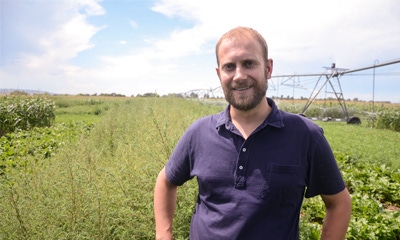
Kochia is easily the No. 1 problem weed for crop growers in western Nebraska. Kochia has been identified with resistance to ALS-inhibitors, triazine, glyphosate and dicamba in Nebraska, with glyphosate-resistant kochia infesting over 2 million acres in the western reaches of the state.
Two years ago, Nevin Lawrence, assistant professor and integrated weed specialist at the University of Nebraska Panhandle Research and Extension Center, began a USDA-funded study to explore different options to control herbicide-resistant kochia. The project is a joint venture between Montana State University, the University of Wyoming and the University of Nebraska-Lincoln.

TOOLS FOR CONTROL: Nevin Lawrence, integrated weed management specialist at the Panhandle REC is participating in a USDA-funded study to explore different options to control herbicide-resistant kochia, including different herbicide programs, tillage and diverse cropping rotations — and how they work together.
"There have been studies on the value of things like herbicide rotations and mixing up modes of action," Lawrence says. "There are also recommendations for tillage and having a diverse cropping rotation. Some have been well-discussed in literature and some not. We're trying to look at all of those practices to see what can actually prevent resistance from getting worse."
4 rotations
The 3-acre research plot includes a comparison of four different rotations: continuous corn; a corn and sugarbeets rotation; a rotation of corn, sugarbeets and dry edible beans; and a rotation of corn, dry beans, sugarbeets and winter wheat. It also evaluates minimum tillage and conventional tillage for control of resistant weeds.

ROTATING DOESN'T WORK: In this dry edible bean field, herbicides were rotated from an ALS inhibitor one year to a treatment designed to control 95% of the kochia. In the second year, kochia is still starting to show up. Lawrence explains rotating modes of actions over years doesn't address dormant weed seed in the soil. If one mode of action fails to control weeds, you can add a tremendous amount of seeds to the soil that can persist for decades.
The study compares different herbicide programs:
• using a single mode of action, an ALS-inhibitor, year after year
• rotating modes of action — using an ALS-inhibitor one year, followed by a different mode of action the second year in a treatment designed to control 95% of the kochia, and returning to the first mode of action for the third year
• using multiple modes of action every year, including an ALS-inhibitor in a mixture designed to control 95% of the kochia
In the first two years of the ALS-only treatment, all crops with the exception of winter wheat have been completely infested by kochia. In the herbicide rotation treatments, results vary depending on crop rotation. The more diverse the crop rotation, the greater the control achieved with the herbicide rotation treatment. However, out of the herbicide programs, the best control comes from using multiple modes of action every year. "In all crop rotations with the ALS mixture treatment, which includes a mixture of ALS and another group of herbicide that provides 95% control, we're seeing hardly any kochia," Lawrence says.
Dormant weed seed
Why doesn't simply rotating herbicides keep resistant kochia from spreading? Lawrence explains resistance usually develops from overuse of a single mode of action. Rotating modes of actions over years doesn't address dormant weed seed in the soil. If one mode of action fails to control weeds, you can add a tremendous amount of seeds to the soil, which can persist for decades.
Depending on the crop, tillage can be a viable tool to control resistant kochia. "We aren't seeing a big difference in wheat because it's planted before kochia comes up," Lawrence says. "But with a crop like dry beans, tillage provides a nice way to kill kochia prior to planting, and we're getting some benefit out of that as opposed to the no-till plots."
Tillage and certain crop rotations can be effective because of kochia's biology as an early-emerging weed. However, Lawrence notes some crops bring more benefit to the rotation than others.
For example, kochia emerges around the same time corn and sugarbeets do. So, these two crops aren't very competitive early on in the season. Winter wheat, on the other hand, is already well-established by the time kochia starts to emerge. That's why winter wheat rotations in this study haven't seen much pressure from kochia. Likewise, dry beans are planted in late spring, giving growers a chance to control kochia up front with a burndown application or tillage.
When it comes to controlling resistant kochia, it's important to think about the entire cropping system and which rotations provide a good chance to use certain tools to control kochia. "Part of my research involves thinking beyond one year for weed control," Lawrence says. "You need to think about your cropping system, and making it work for multiple years, rather than just one."
About the Author(s)
You May Also Like






